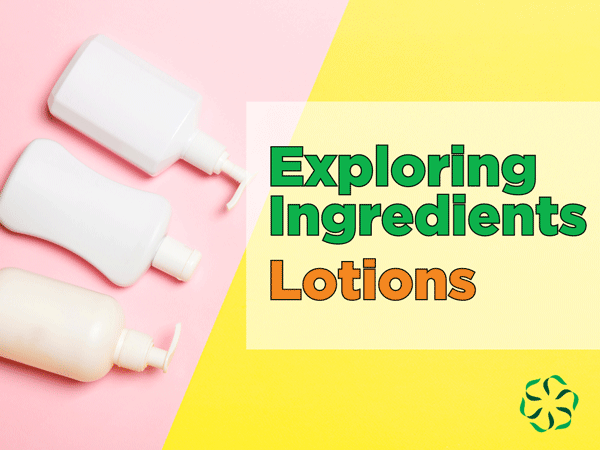In this post, we break down the ingredient labels on four lotions to show the ingredients’ most common purpose in the formulation.
What do I need to know before we dig in?
Remember, ingredients are listed from largest quantity to smallest quantity on a label. Different ingredients require different quantities and different doses to work as intended.
You can learn more about cosmetic product labeling in a prior blog post.
We know that certain ingredients are common to specific products. So, you will notice commonalities and differences in listed ingredients as we explore the ingredient information.
The ingredient differences in similar products don’t necessarily make one product better than another product. Formulations balancing the ingredients are critical to the end product. It’s also quite subjective, what one person may find to work effectively, another person may not have the same success.
Lotions typically contain eight types of ingredients:
- Emollients: help maintain soft, smooth skin.
- Emulsifiers: help ingredients that naturally repel one another (e.g., oil and water) stay together and maintain their consistency.
- Fragrances: provide the pleasant smell common in many products.
- Humectants: help attract and retain moisture to the surface of the skin (1).
- Occlusives: help slow moisture evaporation from our skin’s surface (typically oil-based).
- pH Adjusters: help regulate the pH of a product keeping it safe to use on the skin.
- Preservatives: help prevent unwanted bacteria and fungi from growing in the product (1).
- Solvents: help ingredients dissolve and combine with one another.
There are hundreds of ingredients that fall into the above categories and cosmetic manufacturers will pull ingredients from these (and other) categories to formulate their products.
Please note, we did not manufacture the products we’re exploring in this post. The ingredients and the ingredients’ purposes may be more nuanced and may include other properties not listed. Also, ingredients can have more than one function so some ingredients may be found in more than one category.
Let’s take a look at two lotions both marketing the same scent.
Lotion one: ingredients and their function
Ingredients as listed on the product: water, glycerin, alcohol denat. (denatured alcohol), cetearyl alcohol, cetyl esters, glyceryl dilaurate, cetyl alcohol, ceteareth-20, lanolin oil, dimethicone, fragrance, acrylates/C10-30 alkyl acrylate crosspolymer, sodium hydroxide, chlorphenesin, benzyl alcohol
| Emollients | water, cetyl esters, glyceryl dilaurate, lanolin oil |
| Emulsifiers | cetearyl alcohol, cetyl alcohol, ceteareth-20, lanolin oil, acrylates/C10-30 alkyl acrylate crosspolymer |
| Fragrances | fragrance |
| Humectants | glycerin |
| Occlusives | lanolin oil, dimethicone |
| pH Adjusters | sodium hydroxide |
| Preservatives | alcohol denat., chlorphenesin, benzyl alcohol |
| Solvents | water, alcohol denat., benzyl alcohol |
Lotion two: ingredients and their function
Ingredients as listed on the product: water, glycerin, alcohol denat., cetearyl alcohol, stearic acid, glyceryl dilaurate, dimethicone, cetyl esters, lanolin oil, fragrance, DMDM hydantoin, methylparaben, arginine, sodium hydroxide, propylparaben, acrylates/C 10-30 alkyl acrylate crosspolymer, tocopheryl acetate (Vitamin E)
| Emollients | water, glyceryl dilaurate, cetyl esters, lanolin oil, arginine, tocopheryl acetate (Vitamin E) |
| Emulsifiers | cetearyl alcohol, stearic acid, lanolin oil, acrylates/C 10-30 alkyl acrylate crosspolymer |
| Fragrances | fragrance |
| Humectants | glycerin |
| Occlusives | dimethicone, lanolin oil, tocopheryl acetate (Vitamin E) |
| pH Adjusters | sodium hydroxide |
| Preservatives | alcohol denat., DMDM hydantoin, methylparaben, Propylparaben |
| Solvents | water, alcohol denat., |
Let’s compare two lotions marketed for skin protection properties.
Due to the health claims made by the manufacturers, these lotions are considered over-the-counter (OTC) drugs by the U.S. Food Drug Administration (FDA) and must be labeled in the same way as other OTC products (e.g., medications, sunscreen, etc.) are labeled. The labeling includes calling out an active ingredient as well as the inactive ingredients that make up the product.
Lotion three: ingredients and their function
Active Ingredient: dimethicone 1.2% (skin protectant)
Inactive ingredients: water, glycerin, distearyldimonium chloride, petrolatum, isopropyl palmitate, cetyl alcohol, avena sativa (oat) kernel flour, benzyl alcohol, sodium chloride
| Emollients | water, distearyldimonium chloride, isopropyl palmitate, cetyl alcohol, avena sativa (oat) kernel flour |
| Emulsifiers | cetyl alcohol |
| Fragrances | |
| Humectants | glycerin, avena sativa (oat) kernel flour |
| Occlusives | dimethicone, petrolatum, avena sativa (oat) kernel flour |
| pH Adjusters | |
| Preservatives | benzyl alcohol, sodium chloride |
| Solvents | water, benzyl alcohol, sodium chloride |
Lotion four: ingredients and their function
Active ingredient: Dimethicone 1.3% (skin protectant)
Inactive ingredients: water, glycerin, distearyldimonium chloride, petrolatum, isopropyl palmitate, cetyl alcohol, avena sativa (oat) kernel flour, benzyl alcohol, sodium chloride
| Emollients | water, distearyldimonium chloride, isopropyl palmitate, cetyl alcohol, avena sativa (oat) kernel flour |
| Emulsifiers | cetyl alcohol |
| Fragrances | |
| Humectants | glycerin, avena sativa (oat) kernel flour |
| Occlusives | dimethicone, petrolatum, avena sativa (oat) kernel flour |
| pH Adjusters | |
| Preservatives | benzyl alcohol, sodium chloride |
| Solvents | water, benzyl alcohol, sodium chloride |
What does it all mean?Breaking down the label, we can see the products are formulated to help our skin retain moisture and even protect skin, maintain a consistency that can easily spread and absorb into our skin without separating, remain free from potentially harmful pathogens, and, sometimes, smell nice too.
It takes many ingredients working together in specific quantities to safely create the lotions and cosmetics we use and trust. Understanding that each ingredient serves a purpose and then learning the ingredient’s function, we can make the best decision to fit our personal needs.
We can also see that ingredients are often comparable between brands. If we look at the label, we can make decisions based on the product’s ingredients rather than branding.
Where can I get more information?
You can learn general cosmetic safety information at https://cosmeticsinfo.org.
You can view in-depth cosmetic ingredient safety information and reports at https://www.cir-safety.org/ingredients

